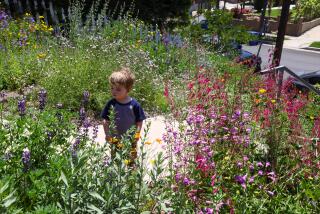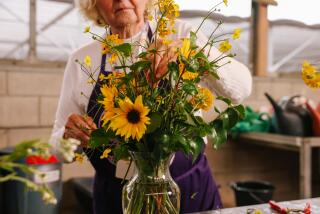‘Forcing’ Summer’s Colors to Winter
- Share via
Jim and Maggie Threadgill are proving that although you can’t fool Mother Nature, you can force her to alter her ways. The couple planted 150 Oriental lilies in their Carlsbad garden Sunday in anticipation of a show-stopping, fragrant burst of color in December.
While most people are enjoying the festive red of poinsettias, the Threadgills will gaze on red amaryllis blooming amid fragrant paperwhites.
The Threadgills used precooled, or programmed, Dutch bulbs to get a summer-blooming bulb to flower in California’s version of winter. The altered timetable is possible because they planted the extra large sizes of bulbs preferred by commercial growers. These programmed bulbs grow on command, a method known as “forcing.”
After the bulbs are carefully planted in holes that are 10 inches deep where the soil is cooler, they flower in 30 to 100 days.
Jim Threadgill is president of Flamingo Gardens Inc., a Vista-based company that grows Oriental and Asiatic lilies, French tulips, daffodils, hyacinths, crocuses and paperwhites.
“Even in our climate, growing Dutch bulbs is easy,” he says. “Cooling them properly is the challenge.”
Gardeners have eagerly purchased bulbs in fall, cooled them in refrigerators for at least six weeks to simulate their required winter chill before planting, then waited for the colorful results in February for crocuses; March or April for daffodils, crocuses, hyacinths; and summer for lilies. Many gardeners, however, get less than picturesque results when the bulbs fail to produce flowers, a condition called “blind production.”
The gardener isn’t responsible, says Threadgill, the home refrigerator is.
Uneven temperatures, incorrect humidity levels and poor air circulation interfere. The biggest culprit is ethylene gas that is produced by ripening fruits and vegetables in the refrigerators. Ethylene gas kills the small flower bud in each bulb.
Commercial warehouses have temperature- and humidity-controlled rooms where specific bulbs are housed according to their needs: Lilies are frozen at 28 degrees; tulips and daffodils at 41 degrees; hyacinths at 49 degrees; and Dutch irises at 64 degrees.
“In Southern California, we have to cool tulips, hyacinths and other bulbs that need winter chilling, and it’s a hassle,” said John Bagnasco, plant buyer for local Armstrong Garden Centers. “Buying chilled bulbs from a store means the gardener can go home and plant them the same day.”
After they flower the first time, the plants revert to their normal growing cycles.
*
Threadgill staggers plantings to extend blooming for up to four months, and for lilies, for the entire year.
“Plant a group of bulbs one week, then plant more several weeks later. Keep planting until early March and you can have spring blooms from December through May,” he said.
Threadgill particularly enjoys lilies, with a strong preference for Orientals. “They’re fragrant, produce long, thick stems with flowers up to 8 inches in diameter.
“Think of them as living floral bouquets,” he says. “But instead of enjoying the flowers for only five or six days, as in a cut-flower bouquet, by planting them in pots or in the ground, the enjoyment can be extended up to weeks or months.”
Winter storms shouldn’t threaten the fragile stems or flowers.
“When lilies are planted in full sun, their stems only grow up to 24 inches. If I want longer stems of up to 5 feet, I plant them near my house entrance where it’s shadier. The plants stretch to get their flowers in the sun. I stake these taller plants and if rain threatens, I cut them just as the first bud cracks color so we can enjoy them indoors.”
Before planting, work in organic amendment so the soil drains quickly. Instead of a bulb booster, which can burn bulbs, scatter a time-release fertilizer on the soil and work it in gently. This feeds the plant after flowering, when it’s storing energy for next year’s bloom period.
For insurance, overplant with colorful bedding plants or ground covers such as pansies, violas and alyssum. These will camouflage the lilies’ leaves when they age and yellow.
Programmed varieties are available at Armstrong Garden Center and Home Depot in mid-November. Information from Flamingo Gardens is available by calling (800) 550-5459.






